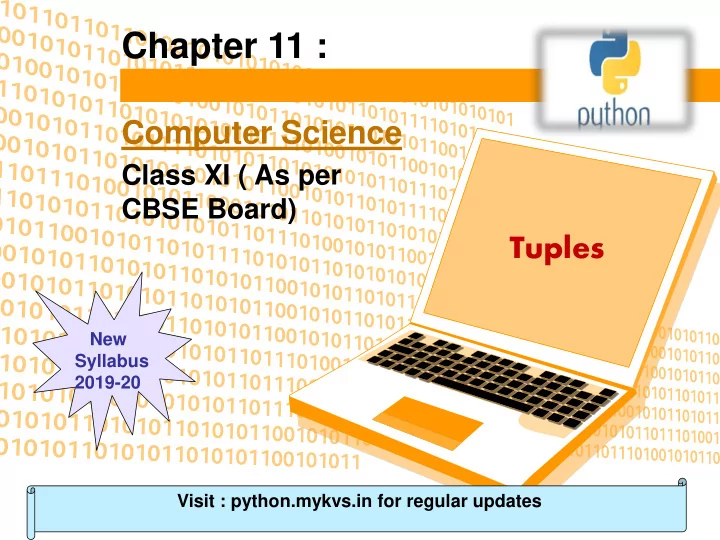

Chapter 11 : Computer Science Class XI ( As per CBSE Board) Tuples New Syllabus 2019-20 Visit : python.mykvs.in for regular updates
Tuples It is a sequence of immutable objects. It is just like list. Difference between the tuples and the lists is that the tuples cannot be changed unlike lists. Lists uses square bracket where as tuples use parentheses. Creating A Tuple A tuple is enclosed in parentheses () for creation and each item is separated by a comma. e.g. tup1 = (‘comp sc', ‘info practices', 2017, 2018) tup2 = (5,11,22,44) NOTE:- Indexing of tuple is just similar to indexing of list. Visit : python.mykvs.in for regular updates
Tuples Accessing Values from Tuples Use the square brackets for slicing along with the index or indices to obtain the value available at that index. e.g. tup1 = ("comp sc", "info practices", 2017, 2018) tup2 = (5,11,22,44,9,66) print ("tup1[0]: ", tup1[0]) print ("tup2[1:5]: ", tup2[1:5]) Output ('tup1[0]: ', 'comp sc') ('tup2[1:5]: ', (11, 22, 44, 9)) Visit : python.mykvs.in for regular updates
Tuples Iterating Through A Tuple Element of the tuple can be accessed sequentially using loop. e.g. tup = (5,11,22) for i in range(0,len(tup)): print(tup[i]) Output 5 11 22 Visit : python.mykvs.in for regular updates
Tuples Updating Tuples Tuples are immutable,that’s why we can’t change the content of tuple. It’s alternate way is to take contents of existing tuple and create another tuple with these contents as well as new content. E.g. tup1 = (1, 2) tup2 = ('a', 'b') tup3 = tup1 + tup2 print (tup3) Output (1, 2, 'a', 'b') Visit : python.mykvs.in for regular updates
Tuples Delete Tuple Elements Direct deletion of tuple element is not possible but shifting of required content after discard of unwanted content to another tuple. e.g. tup1 = (1, 2,3) tup3 = tup1[0:1] + tup1[2:] print (tup3) Output (1, 3) NOTE : Entire tuple can be deleted using del statement. e.g. del tup1 Visit : python.mykvs.in for regular updates
Tuples Basic Tuples Operations Python Expression Results Description len((1, 2)) 2 Length (1, 2) + (4, 5) (1, 2, 4, 5) Concatenation (‘CS',) * 2 (‘CS', ‘CS‘) Repetition 5 in (1, 2, 3) False Membership for x in (4,2,3) : print 4 2 3 Iteration (x, end = ' ') Visit : python.mykvs.in for regular updates
Tuples Tuple Functions S.No. Function & Description tuple(seq) Converts a list into tuple. 1 min(tuple) Returns item from the tuple with min 2 value. max(tuple) Returns item from the tuple with 3 max value. len(tuple) Gives the total length of the tuple. 4 cmp(tuple1, tuple2) Compares elements of both 5 tuples. Visit : python.mykvs.in for regular updates
Tuples *Fibonacci series in tuple. nterms = 10 n1 = 0 n2 = 1 count = 0 tup=() # check if the number of terms is valid if nterms <= 0: print("Please enter a positive integer") elif nterms == 1: print("Fibonacci sequence upto",nterms,":") print(n1) else: print("Fibonacci sequence upto",nterms,":") while count < nterms: tup=tup+(n1,) nth = n1 + n2 # update values n1 = n2 n2 = nth count += 1 print (tup) Visit : python.mykvs.in for regular updates
Recommend
More recommend